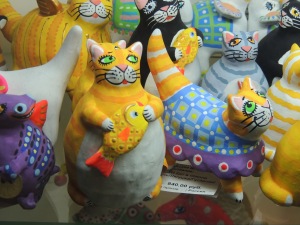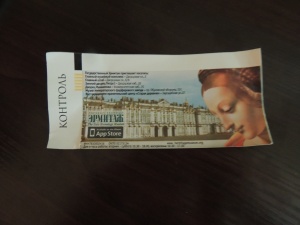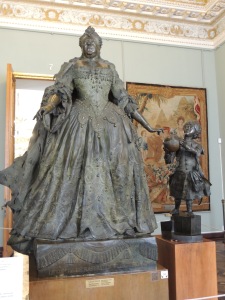Dear St. Petersburg,  You’ve had as many names as I have!
You’ve had as many names as I have!
Married to the great swells of history, the city has been St Petersburg from its founding in 1703 until 1914, Petrograd from WWI 1914 until 1924, Leningrad from 1924 until the fall of the Soviet regime in 1991, then St Petersburg again from 1991 until now.
St Petersburg also enjoys many unofficial titles: It is the Venice of the North, for its canals and waterways. It is the City of Three Revolutions, for a Century of upheavals between monarchy, communism, and democratization. It is also Palmyra of the North, for its neo-classical style and its role as a cultural crossroads between West and East. Mavens compare the city to 2,000 year old Palmyra, which was once a wealthy, camel stop with advanced architecture and a complex city plan.
We arrive by train and observe the immaculate station with marble niches for statuary. The pace of the city is hurried, but not as frenetic as Moscow. We’ve eased into the metropolis by sitting for a lesson on the Cyrillic alphabet from our perennially patient guide, Tatiana. The mystery lifts from some of what we can now read. Though we give respect to the tongue – Sounding out a written word is not the same as understanding its meaning.
How interesting to leave Novgorod – a medieval city dating to the 800’s – for an Imperial favorite, St Petersburg, built a thousand years later. Peter the Great, the city’s namesake, reportedly conscripted Russian peasants and Swedish prisoners of war to build his maritime dream on the middle taiga lowlands along the Gulf of Finland in 1705. Tens of thousands died in the process, but they remain nameless. Some 200 years later, the Germans blockaded St Petersburg during WWII. The seige claimed a million lives due to starvation, winter cold, and disease. Later, when the Soviet communist bloc broke in the early 1990’s, St. Petersburg suffered from a broken economy. Food was rationed, and it was a decade before things bettered.
“Venice of the North” is a bad euphemism for more than 300 floods that destroyed buildings and caused the city of 100 islands to reorganize. It was not until the 1850’s that pontoon bridges were abandoned for permanent structures. A needed series of dams began in 1980, stalled during the difficult recession years, then were finally completed in 2011.
The hydro project includes completion of about 30 water purification stations, as well. Inept handling of phosphates and human waste plagues the City’s ability to cleanse its water. In the hotel, bottled water stations stand at each floor. Common understanding cautions the use of tap water for any reason other than bathing.
At midnight, we board a barge for a sail along the Neva River. Because the city has a series of more than 500 bridges of varying size and age, bridges lift each night to allow large vessels to pass. Lifted bridges mean that the island suburbs that they serve are temporarily cut off. The accomodation is to lift bridges at 1:30 AM each morning, when most who are affected are expected to be asleep.
The late night boat ride is beautiful. St Petersburg lights its main bridges in color. The buildings along the Neva stay bathed in white light all night. Happily for aesthetics – particularly at night – St Petersburg’s developers are prohibited by a 1762 Code from building anything higher than the Winter Palace. As 1:30 AM approaches, more and more people line the banks to see the bridges rise. Boats collect. Cheers quickly raise as the bridges take their turn going slowly up. 
Near Nevsky Prospekt, the venerable main street of the city, the national military school trains the next generation of soldier scholars. Young cadets in uniform are in the street with their parents for the week-end.
This is a walkable city, with beautiful parks. The scent of roasted nuts leads us to a vendor.
At the Church of Spilled Blood, we see why the site magnetizes visitors. The many domes and mosaics and iconography on the exterior are picture perfect for the devout and curious alike. The city’s souvenir market is conveniently situated in the church’s shadow. One of the bridges leading to the church attracts bridal parties for photographs.  Another tradition sees the bridal party cheer the newlywed couple as the groom runs across the bridge toward the church, carrying his bride.
Another tradition sees the bridal party cheer the newlywed couple as the groom runs across the bridge toward the church, carrying his bride.
The Hermitage is similarly an irresistable visit. It is home to Catherine the Great’s art collection. And as her former home, it is one of the most lavish known to have been occupied by arguably the world’s most famous hoarder. We are hours in the midst of the gilt and galleries. We’re separated as one tour group after another floods the royal aviary where the Peacock clock is exhibited.
We’re separated as one tour group after another floods the royal aviary where the Peacock clock is exhibited. 
I run like a Petersburger, and jump into the press of a rush hour crowd on a bus along Nevski Prospekt. I hold out my fare, but no one takes it. Four blocks later, I leap back onto the curb and weave the same path taken by Judi back to the hotel.
Earlier in the day, Judi and I stop for coffee at a shop named for Pushkin. This stop is but one of the consistently entertaining and delicious meals that we find in St Petersburg. St Petersburg feels very Continental in the manner of its cafes, the dominant presence of neo-classical buildings, and its cosmopolitan shops and people.
The State Museum holds its austere own with well cared for collections of art and artifacts of Russian origin. Sometimes, the museum pits the outlying areas against curators, as when the church doors dating from the 1500s were removed from Novgorod for display in St Petersburg.
